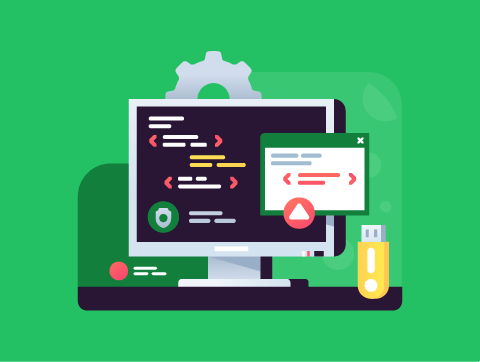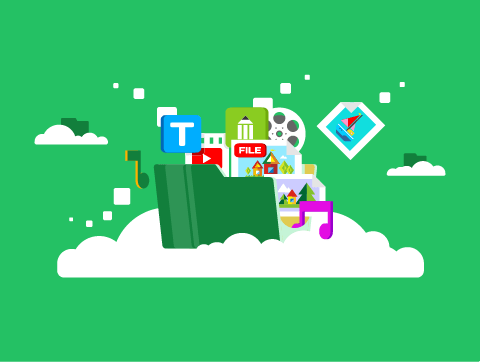Introduction
Over the previous three lessons, we’ve looked at a wide range of different creative media products, including many traditional media formats such as video, audio, music & animation.
However, the growth of the new media sectors has led to a rise in many newer forms of media products that we haven’t seen before.
Many of these have become very popular in recent years and continue to grow in popularity.
In this lesson, we will learn about:
- Websites
- Multimedia
- eBooks
- VR/AR
Websites
A website is a series of interconnected web pages.
These web pages are made using a language called HTML and combine text and images, usually with the goal of providing information.
Websites provide a platform for media industry businesses to showcase their content and products and reach a worldwide audience.
As a result, using a website can boost customer engagement and increase sales.
Websites are the main product used by the Internet media sector. However, all media sectors use websites to showcase their products and content.

How Media Sectors Use Websites
Film
Websites for promoting movies, sharing trailers, providing information on cast and crew, and selling tickets for screenings. Streaming platforms also host movies online.
Television
Websites for TV networks and individual shows, streaming platforms that offer on-demand TV content, and promotional materials like trailers and interviews.
Radio
Websites for radio stations, providing information about shows, hosts, and schedules, as well as offering live streaming and on-demand audio content.

How Media Sectors Use Websites
Print Publishing
Websites for newspapers, magazines, and book publishers for sharing content, promoting publications, and selling subscriptions or individual copies.
Computer Games
Websites for game developers and publishers offering information, trailers, and game downloads or sales. Also, gaming news websites, forums, and communities.
Interactive Media
Websites that host interactive content, such as virtual experiences and interactive storytelling.

How Media Sectors Use Websites
The Internet
This sector inherently relies on websites as its primary medium. It includes websites that publish news, articles, and multimedia content, as well as e-books, online courses, and more.
Digital Publishing
Websites for hosting, distributing, and promoting various forms of digital content, such as articles, e-books, multimedia, and interactive experiences.

Multimedia
Multimedia products combine various types of media, such as text, audio, images, animation & video into a single product.
For example, multimedia products include PowerPoint presentations, museum experiences & interactive touchscreens.
The main media industry sectors that use multimedia products are film, television, computer games, interactive media & the Internet.

How Media Sectors Use Multimedia
Film
Interactive DVD extras, behind-the-scenes content, and other promotional materials often incorporate multimedia elements.
Television
Similar to film, TV shows may use multimedia products for promotional materials, interactive features, or behind-the-scenes content.
Computer Games
In addition to the games themselves, multimedia elements can be found in promotional materials, bonus content, or in-game tutorials.

How Media Sectors Use Multimedia
Interactive Media
By its nature, this sector heavily relies on multimedia products, as it involves the use of multiple media formats in interactive applications, such as presentations & information kiosks.
The Internet
Websites, social media platforms, and online advertising all employ multimedia products to engage users and provide a richer experience.

eBooks
E-books are digital books that can be read on an eBook reader, such as a Kindle, or on smart devices using an eReader app.
We can get all kinds of books as eBooks, such as educational textbooks, technical manuals, fiction novels & comics.
Due to the decline in popularity of physical publishing products such as books, eBooks have provided an excellent alternative for the publishing industry.
The main media industry sectors that use eBooks are print publishing, interactive media, the internet & digital publishing.

How Media Sectors Use eBooks
Print Publishing
Traditional publishers often offer digital versions of their printed works as eBooks, expanding their reach and catering to readers who prefer digital formats.
Interactive Media
eBooks can incorporate multimedia elements and interactive features, such as animations, audio, quizzes, or hyperlinks, blending traditional text with interactive content.

How Media Sectors Use eBooks
The Internet
eBooks are frequently distributed and accessed online through various platforms, such as online bookstores, libraries, or direct downloads from publishers or authors’ websites.
Digital Publishing
This sector is primarily focused on creating and distributing digital content, including eBooks, which can be read on devices like e-readers, tablets, and smartphones.

VR/AR
Virtual Reality (VR) and Augmented Reality (AR) are the most recently developed forms of media and are still rapidly developing & evolving.
VR/AR can be described as “products and software that bridges the digital and physical worlds”.
The difference between VR and AR can be defined as follows. VR immerses users in a fully computer-generated environment, replacing their real-world surroundings.
In contrast, AR overlays digital information or graphics onto the user’s view of the real world, enhancing their perception without replacing it entirely.
The main media industry sectors that use VR and AR are film, television, computer games, interactive media & the Internet.

How Media Sectors Use VR/AR
Film
VR and AR can be used to create immersive storytelling experiences, allowing viewers to explore virtual environments and interact with characters and objects within the story.
Television
VR and AR can enhance traditional television content by providing immersive, interactive, or supplementary experiences, such as virtual sets or additional information overlaid on the screen.
Computer Games
VR and AR technologies are widely used in gaming to create immersive and interactive experiences, allowing players to fully engage with the game world through devices like VR headsets or AR-enabled smartphones.

How Media Sectors Use VR/AR
Interactive Media
This sector encompasses a wide range of media formats that use VR and AR to create immersive, engaging, and interactive content, such as virtual art installations, educational experiences, and simulations.
The Internet
VR and AR applications can be found on the internet, enabling users to access virtual experiences through web-based platforms or mobile apps.

Lesson Summary
Websites provide a platform for media industry businesses to showcase their content and reach a worldwide audience.
All traditional and new media sectors use websites.
Multimedia products combine different media into a single product.
Multimedia products are used by the film, television, computer games, interactive media & internet sectors.
eBooks are digital books that can be read on any eBook reader.
eBooks are used by the print publishing, interactive media, the internet & digital publishing sectors.
VR immerses users in a fully CG environment, while AR overlays digital graphics onto the user’s view of the real world.
VR & AR are used by the film, television, computer games, interactive media & internet sectors.

